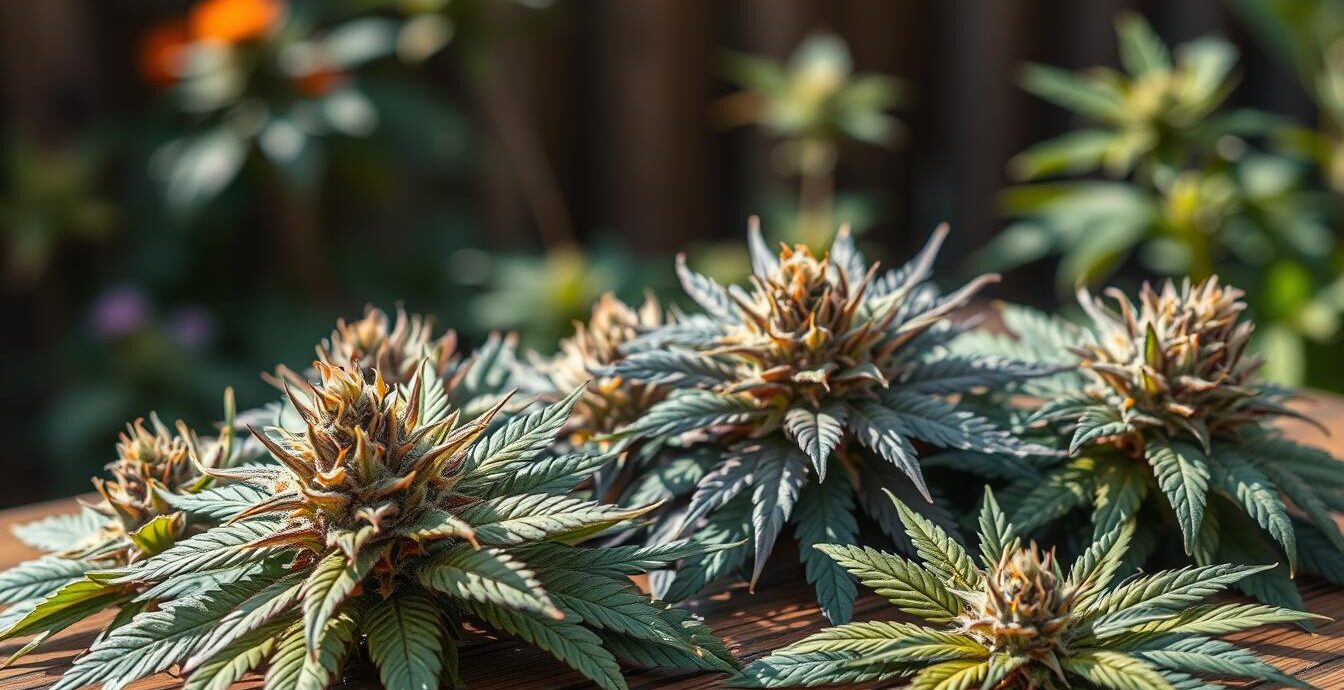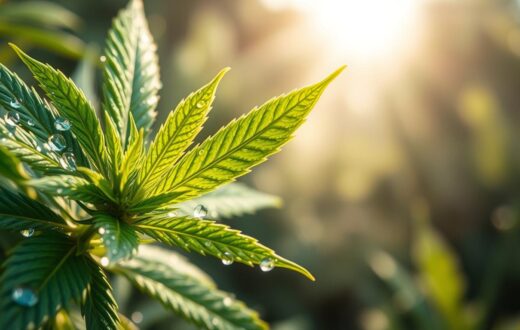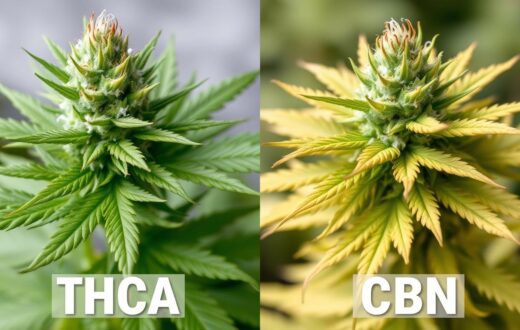Ever wondered about enjoying cannabis without a strong high? Low-THCA strains might be what you’re looking for. These special types of cannabis sativa offer a milder experience. They’re great for daytime use and newcomers to hemp flower.
Low-THCA strains are becoming popular among both fun users and those seeking medical relief. They provide a balanced way to use cannabis, offering benefits without a strong high. But what makes these strains stand out?
Let’s explore low-THCA and CBD strains. For example, Area 52’s THCA Exotic Flower has 30% THCA. Koi’s Lemon Cherry Gelato flowers have 25% THCA. These high percentages might seem surprising, but remember, THCA isn’t psychoactive until it’s heated.
Curious about how these strains compare to traditional high-THC ones? Wondering if they’re right for you? Stay with us as we delve into the world of low-THCA cannabis. We’ll uncover its potential benefits together.
What Are Low-THCA Strains?
Low-THCA strains are a special type of legal cannabis. They have very little THCA, the non-psychoactive part of THC. These strains might offer benefits without the strong “high” that comes with cannabis.
Definition of THCA
THCA, or tetrahydrocannabinolic acid, is found in raw cannabis plants. It’s one of many cannabinoids, like CBD. Unlike THC, THCA doesn’t make you feel high until it’s heated up.
Distinction Between THCA and THC
THCA and THC have different effects on the body. THC makes you feel high, but THCA doesn’t. This makes low-THCA strains good for those wanting cannabis benefits without the high.
These strains have less than 10%-15% THC. For example, Cannatonic has 4% THC and 9% CBD. Harlequin has 5% THC and 9% CBD. They’re great for daytime use because they might help with anxiety and pain.
Benefits of Low-THCA Strains
Low-THCA strains have special benefits for those who use medical marijuana. They offer relief without the strong “high” feeling. This makes them great for those who want to feel better without losing focus.
Therapeutic Effects
Studies show that low-THCA strains could be very helpful. They might reduce inflammation, stop nausea, and ease pain. A 2017 study found that THCA could protect the brain, which might help with diseases like Alzheimer’s.
Potential for Non-Psychoactivity
One big plus of low-THCA strains is they don’t make you feel “high.” THCA only turns psychoactive when heated. This means you can get health benefits without feeling drowsy or confused. It’s perfect for using during the day when you need to stay sharp.
High-CBD strains often have a bit of THCA in them. This mix can be very good for managing symptoms. People say it helps them relax, feel less pain, and think more clearly. Some even use it to help with seizures.
But, remember, everyone is different when it comes to cannabis. It’s smart to start with a small amount and talk to a doctor before trying any new product.
Popular Low-THCA Strains
Cannabis cultivation has led to many hemp flower strains with low THCA content. These strains offer unique experiences for users. They seek the benefits of cannabis without intense psychoactive effects.
Watermelon Zkittles
Watermelon Zkittles is a favorite among low-THCA enthusiasts. It has a high limonene content, which may uplift moods. Its sweet, fruity aroma makes it a pleasant choice for those new to hemp flower.
Strawberry Mimosa
Strawberry Mimosa is known for its energetic and social effects. It’s perfect for daytime use, offering a boost of creativity and focus. Its flavor profile mirrors its name, with notes of strawberry and citrus.
Pineapple OG
Pineapple OG provides a balanced experience suitable for relaxation. This strain offers a tropical aroma and flavor, making it a popular choice for evening use. Its mild effects make it ideal for those seeking gentle relief without overwhelming sensations.
These low-THCA strains showcase the diversity in hemp flower cultivation. Each offers unique characteristics, catering to different preferences and needs in the world of cannabis. As the industry evolves, we can expect to see even more innovative low-THCA options emerging.
How Low-THCA Strains Are Cultivated
Growing cannabis sativa with low THCA levels is a detailed task. Farmers pay close attention to specific techniques. This ensures the hemp flower has the right cannabinoid profile.
Growing Conditions
Low-THCA strains need careful environmental control. Growers manage light, temperature, and humidity. They also use special soil and feeding schedules.
This helps boost other beneficial compounds. It limits THCA production in the hemp flower.
Harvesting Techniques
Timing is key when harvesting low-THCA cannabis sativa. Farmers watch trichome development closely. They pick the plants at the perfect moment for the best cannabinoid balance.
Some growers use “early harvesting” to keep THCA levels low. After harvest, proper drying and curing are crucial. These steps preserve the flower’s quality and prevent THCA from converting to THC.
Many cultivators use organic methods. This ensures pure, high-quality hemp flower. By focusing on these techniques, farmers can produce low-THCA strains with unique benefits.
The Science Behind THCA
THCA is a key player in the world of cannabinoids. It’s found in raw cannabis and is the precursor to THC. Unlike THC, THCA doesn’t cause a high. It’s one of over 500 cannabinoids in the cannabis plant, each with unique properties.
Understanding Cannabinoids
Cannabinoids are natural compounds in cannabis that interact with our body’s endocannabinoid system. This system plays a role in many bodily functions. THCA stands out among cannabinoids for its potential health benefits. It may have anti-inflammatory and neuroprotective effects. Some studies suggest it could help with nausea and seizures.
THCA’s Role in the Cannabis Plant
In the cannabis plant, THCA serves as a building block. It’s abundant in live and freshly picked plants. When exposed to heat or light, THCA changes into THC. This process, called decarboxylation, is what makes cannabis psychoactive. Without heat, THCA remains non-intoxicating. This is why eating raw cannabis won’t get you high.
Terpenes, another group of compounds in cannabis, work with cannabinoids. They create the plant’s unique scents and flavors. Together, cannabinoids and terpenes may enhance each other’s effects. This teamwork is known as the entourage effect. It’s a key area of interest in cannabis research.
Medical Uses of Low-THCA Strains
Low-THCA strains of medical marijuana are getting more attention for their health benefits. They offer special advantages for those looking for relief without the strong effects of high-THC cannabis.
Pain Management
Research indicates that low-THCA strains can help with pain. A survey of 1,028 people showed that 80.1% found medical cannabis effective. Many found indica strains helpful for pain and sleep.
Anti-Inflammatory Properties
THCA, the non-intoxicating precursor to THC, has shown anti-inflammatory effects. This makes low-THCA strains good for conditions like arthritis and inflammatory bowel disease. They may offer relief without the strong effects of high-THC varieties.
Antioxidant Effects
Low-THCA strains also have antioxidant properties. These can protect cells from damage. For those with chronic conditions, this could offer extra health benefits.
More research is needed, but high-CBD, low-THCA strains show promise. Always talk to a healthcare professional to find the best treatment for your needs.
How to Select Low-THCA Strains
Finding the right low-THCA strain can be challenging. We’ll show you how to pick the best hemp flower for you. There are important factors to think about when choosing a strain.
Factors to Consider
First, check the cannabinoid profile. Strains with 10-15% THCA are good for beginners. More experienced users might prefer strains with 20% or more THCA. The terpene profile is also crucial.
Terpenes like myrcene, limonene, and caryophyllene affect the strain’s effects and taste. Think about what effects you want. Indica strains help you relax, while sativa strains boost energy. Hybrids offer a mix of both.
Don’t overlook aroma and flavor. They can make your experience even better.
Consult with Professionals
Talking to cannabis experts or budtenders is a good idea. They can give you insights and match a strain to your needs. They might recommend popular low-THCA strains like Cherry Wine or Lifter, known for their high CBD content.
Remember, finding your perfect strain is a process. Keep a journal of your experiences. This will help you refine your choices and find the best hemp flower for you.
Where to Purchase Low-THCA Strains
Finding legal cannabis and hemp flower with low THCA levels is easier than ever. You can explore various options to get your hands on these sought-after strains.
Online Options
The internet offers a vast selection of low-THCA strains. Many online retailers provide 100% of their THCA strains from top hemp farms in the United States. These shops often label their products as premium and grow them indoors for optimal quality.
When buying online, you’ll find a wide range of choices. From Indica-dominant strains like Grape Frosty to Sativa-leaning options such as Sex Panther.
Local Dispensaries
Your nearby dispensary is another great place to find low-THCA strains. These local shops often carry popular varieties like Animal Face, which boasts 29.3% THCa, or Tropicana Cherry with 31.4% THCa.
Visiting a dispensary allows you to see and smell the product before buying. You can also chat with knowledgeable staff about different strains and their effects.
Whether you choose to shop online or visit a local store, always check for third-party lab results. These tests ensure you’re getting a quality product that matches its description. Remember, while raw THCA strains don’t produce euphoria, they convert to THC when heated. This offers potential benefits like relaxation and pain relief.
Legal Status of Low-THCA Strains
The legal world of low-THCA strains is complex and keeps changing. The 2018 Farm Bill was a big step. It took hemp out of the list of controlled substances. This made hemp flower with 0.3% or less THC legal.
Federal Regulations
At the federal level, THCA products are okay if they have no more than 0.3% delta-9 THC. This has led to more THCA products in the U.S. market. Many states now let people buy these products, but the rules vary a lot.
State-Specific Laws
State laws on low-THCA strains are different. Texas, for example, follows federal rules on THCA sales. The state has over 7,700 registered retailers of hemp products. California and Florida also allow THCA products, but Idaho and Louisiana don’t.
It’s important for buyers to check local laws before buying low-THCA products. The laws can change fast. What’s legal in one state might be banned in another. Always check the latest laws to follow both federal and state rules with legal cannabis or hemp flower.
User Experiences with Low-THCA Strains
We’ve gathered insights from users of low-THCA strains. These include those who use medical marijuana and cannabis sativa varieties. Their experiences show how these unique plant varieties help different people.
Testimonials from Medical Users
Many medical users find low-THCA strains helpful for managing pain and anxiety. One user said, “I use a low-THCA strain for my chronic back pain. It gives me relief without making me feel too high.” Another user reported, “As someone with anxiety, I love that I can use these strains and still function normally throughout my day.”
Feedback from Recreational Consumers
Recreational users also appreciate low-THCA strains. One consumer noted, “I enjoy the mild effects. It’s perfect for social situations where I want to relax but stay clear-headed.” Some users report enhanced creativity, with one stating, “I use a low-THCA strain when I’m working on art projects. It helps me focus without feeling impaired.”
Both medical marijuana patients and recreational users of cannabis sativa strains with low THCA levels often report improved sleep quality. One user shared, “I fall asleep easier and wake up feeling more refreshed.” These diverse experiences highlight the versatility of low-THCA strains in meeting various needs.
Comparison with High-THC Strains
Low-THCA strains differ from high-THC ones in potency and effects. They offer a special experience for cannabis users. This is because of their unique traits that stand out from high-THC strains.
Potency Levels
Low-THCA strains have up to 40% THCA, which turns into THC when heated. This process changes about 87.7% of it, leading to a milder effect. In contrast, high-THC strains have more THC, causing stronger effects.
Effects and User Preferences
People often pick low-THCA strains for daytime use or if they’re sensitive to THC. They work differently with the body’s endocannabinoid system. This can lead to a softer experience, with less impact on the mind.
Terpenes in these strains also add to their special effects and tastes. User preferences vary based on what they want and their lifestyle. Some like low-THCA for its potential health benefits without strong psychoactive effects. Others prefer high-THC for more intense fun. It really depends on what each person needs or wants.
Future of Low-THCA Strains in Cannabis Industry
The cannabis industry is changing fast, with low-THCA strains becoming more popular. As more places allow legal cannabis, these strains will be key in the future. Now, 54% of Americans live in states where you can buy recreational marijuana, boosting demand for different cannabis products.
Emerging Trends
More people want low-THCA strains for their health benefits without the strong high. These strains are getting more expensive, with growers earning three times as much as those growing CBD. This trend will likely grow as more look to cannabis for health reasons.
Potential Research Developments
Scientists are diving deeper into low-THCA strains, looking to improve their health benefits. The US cannabis market is expected to hit $40 billion by 2024, driving research and development. This could uncover new uses for low-THCA strains, like managing pain and anxiety.
The outlook for low-THCA strains is bright. As legal markets grow and research advances, we’ll see more products tailored to what people want. This could change the cannabis industry, opening up new chances for everyone involved.
Common Myths About Low-THCA Strains
Low-THCA strains of cannabis sativa are becoming more popular. But, myths still surround them. Let’s look at some common misconceptions about these unique hemp flower varieties.
Debunking Stereotypes
Many think low-THCA strains are weak. This is not true. Area 52’s THCA Disposable Vape Pen has 400 mg of THCA, 1100 mg of HHC, and 280 mg of CBD. Finest Labs also offers a product with the same strong mix. These show that low-THCA doesn’t mean low power.
Clarifying Misconceptions
Another myth is that low-THCA strains are limited. But, brands like Secret Nature have unique strains like Oreoz, LA Kush, and Purple Rain. Hemp Generation even has ten different bud strains. This variety shows low-THCA hemp flowers come in many forms.
Some believe low-THCA strains have no health benefits. But, research shows THCA has anti-inflammatory, neuroprotective, and anti-arthritic properties. It might help with conditions like Huntington’s disease and rheumatoid arthritis. These findings challenge the idea that only high-THC strains are medicinal.
Conclusion: The Value of Low-THCA Strains
Low-THCA strains are changing the game in medical marijuana. They offer many benefits without the strong psychoactive effects of high-THC strains.
Summary of Benefits
Low-THCA strains are versatile and easy to get. They come from hemp, making them available in more places in the U.S. This makes them a good choice for those looking for wellness options.
These strains have potential health benefits. Studies show THCA might protect the brain, reduce inflammation, and help with nausea. This makes them a great option for natural health remedies.
As the cannabis world grows, low-THCA strains will become more important. They offer a balance between enjoying cannabis and avoiding the strong highs of high-THC products. Whether you’re a medical marijuana user or just interested, low-THCA strains are worth checking out.















